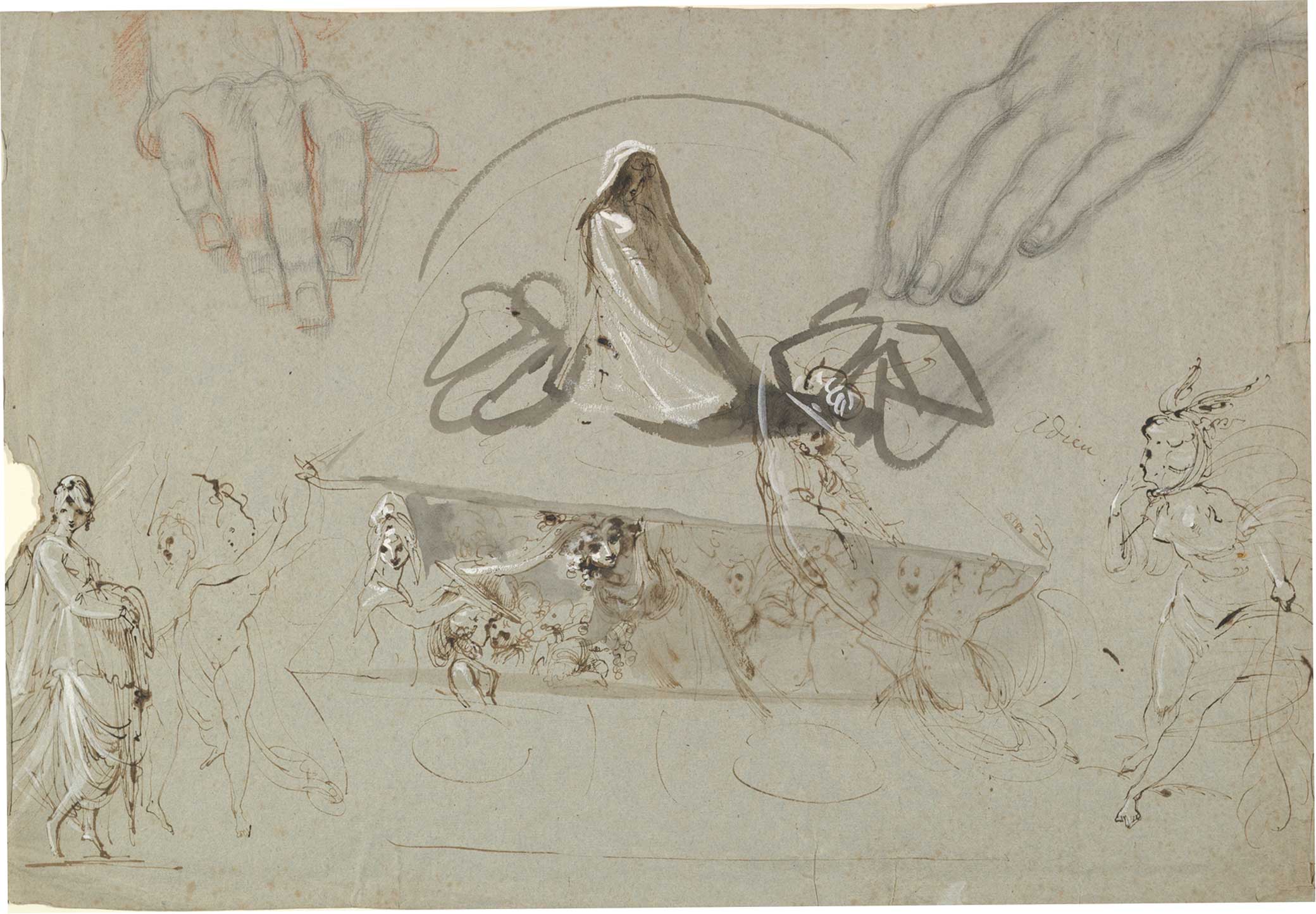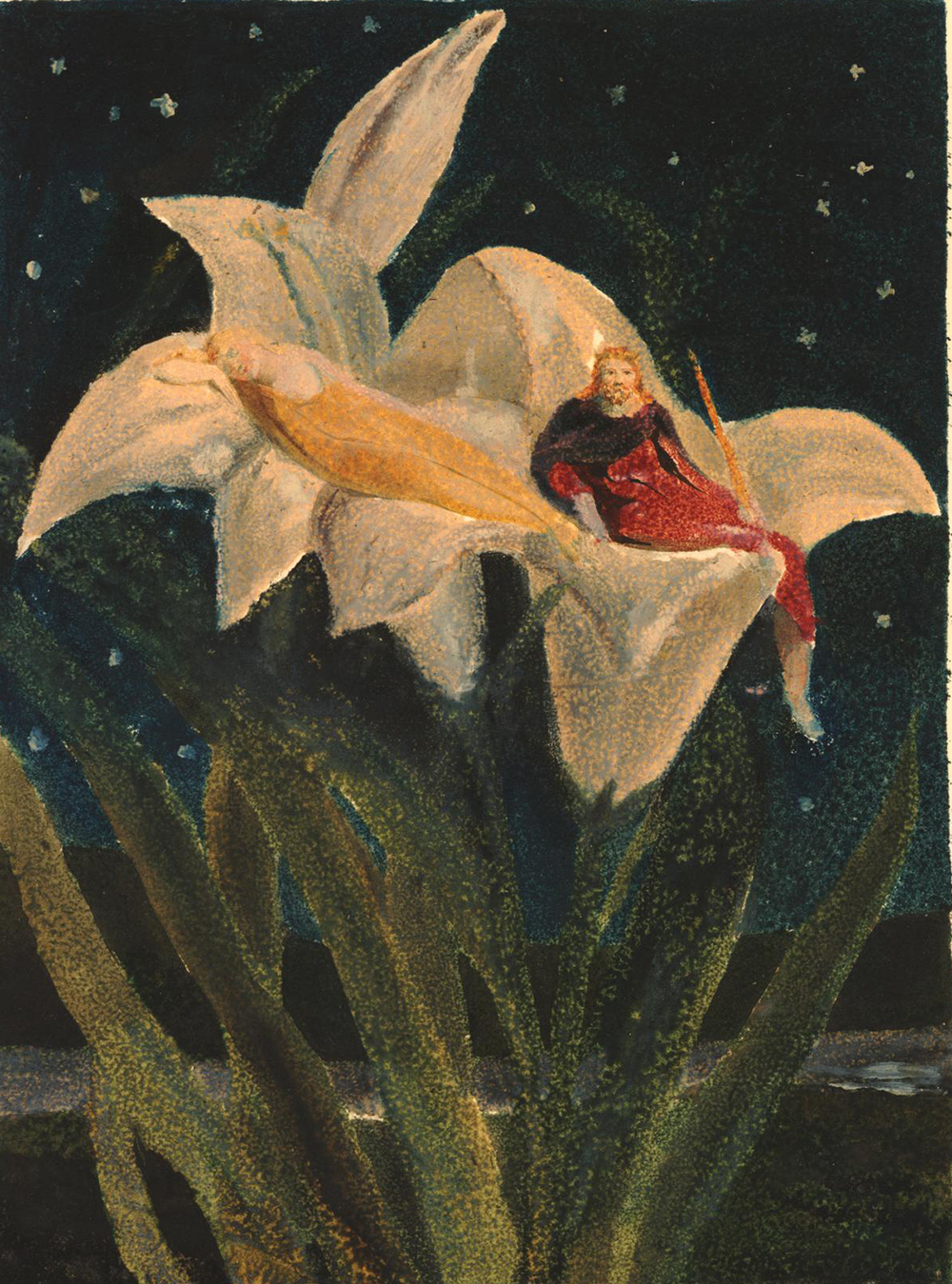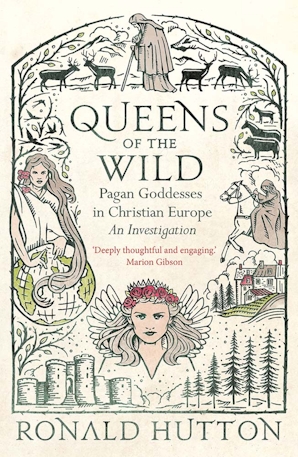
Studies of Fairies with a Pair of Hands, by William Lock the Younger, 1784. The Metropolitan Museum of Art.
Early and high medieval Britain did not have fairies, because the term had not yet been imported, but the parts of it which spoke English and Scots had roughly equivalent beings called elves, who were later to be elided with the category of fairy. The best extant study of the belief in them in Anglo-Saxon England has (inadvertently) revealed how little actually we know of it. It is very clear that they were regarded as a menace, being held responsible for the infliction of sudden and mysteriously originating illnesses, rashes, and pains in humans and their animals. Early English medical texts had various remedies for these, and protections against elf attack. It is also possible, though much less certain, that they targeted particular individuals, perhaps because the latter were in some way transgressive of human social norms, and so were not a habitual menace to society as a whole. A few authors increasingly equated them with demons or monsters, but there are strong linguistic hints in other texts that they could be beautiful and seductive (if dangerous), especially in female form, and these also seem to get stronger as the Anglo-Saxon period went on. There may in addition be some association of them with diviners or prophets, but there is no unequivocal evidence that they taught skills to or shared their powers with favored people. There are no extant stories about them in Anglo-Saxon, or references to any, and no sense of a coherent tradition of them seems to emerge from the evidence. They certainly seem to have been regarded as existing within no parallel political or social system of their own, being treated instead as individual and capricious operators.
It must be emphasized, however, that these reflections are based on a very sparse and patchy survival of texts, all of which were created by a small, learned, clerical, male elite, and this may badly have skewed our impressions. Moreover, because our knowledge of context is so cloudy, confusion and ambiguity remain concerning specific bits of linguistic evidence. One example which may be chosen here is the Anglo-Saxon personal name Aelfwine, “elf-friend.” Does it indicate that special people were expected to enjoy warm and mutually beneficial relationships with elves, by which the latter helped and aided them? Or was the name a gesture of propitiation to flatter and mollify elves, and so make the bearer less vulnerable than others to their attacks? We simply do not know, and that lack of knowledge is one illustration of our general ignorance concerning the ways in which these beings were regarded.
The probability that no coherent view of elves was held in early medieval England is increased by the evidence provided by famous texts from the twelfth and thirteenth centuries, which have become more or less canonical in studies of British fairy tradition: those of Gerald of Wales, Ralph of Coggleshall, Gervase of Tilbury, Walter Map, and William of Newburgh. These dealt with alleged encounters of humans with nonhumans in a human-like form who could not easily be fitted into conventional Christian concepts of angels or demons. Some of these occupied a parallel world to the human one, usually accessed through portals in hollows, mounds, lakes, or hills, where they had a complete society, and were longer-lived and in other ways superior to humanity. Sometimes they were especially associated with the color green, and some lived in or near people’s homes, which they could enter to disrupt the occupants with mischievous tricks or assist them by performing useful tasks. Some blessed individual people who treated them graciously and generously, but some were apparently hostile to all humans, and afflicted them especially by leading them astray at night into pits or bogs. In one of the anecdotes recounted by Gerald of Wales, a boy in the Gower Peninsula went underground into a beautiful realm populated by a blond race of small human size who were ruled by a king. No real interest was shown in the tale, however, concerning this potentate, and the motif of a parallel kingdom was generally missing from the accounts furnished by these scholars.
Those accounts lack, indeed, any sense of a coherent belief system within which to contain and explain these stories. They cannot represent more than a portion of popular belief, because they entirely lack accounts of the infliction of injuries on people by such beings, without direct provocation, which are so prominent in the Anglo-Saxon sources and would be again later in the Middle Ages. On the other hand, the anecdotes strongly suggest that the beliefs and anecdotes concerned were shared by different social classes. As a number of modern scholars have pointed out, the intellectuals who recorded them struggled to create both a meaningful category within which to group them and a language for the beings described, as the range of Latin terms available did not quite seem to match the latter. Collectively, they failed in both enterprises and often candidly admitted their puzzlement.
There was, in addition, a tradition widely distributed across Western Europe, which like the Anglo-Saxon elves must derive from pre-Christian culture, of woodland beings which could take the form of beautiful people, of either gender, and have sexual intercourse with the humans whom they encountered and seduced. These seem to have been equivalent to the classical Greek and Roman nymphs and satyrs, and were variously described by clerical authors as silvani (wood beings), Pans, agrestes feminae (wild women), fauns, or Dusii. The authors concerned naturally equated them with demons, and wrote to condemn the belief in them. Such authors spanned the fifth to the eleventh centuries and included such prominent ecclesiastics as Augustine of Hippo at the opening of that period and Burchard of Worms at its end. It is not clear whether this belief extended to Anglo-Saxon England. One eleventh-century medical English text prescribes a salve “against elf-kin and against a night-walker and against (or for) people who have sex with a (or the) devil.” Once more, however, our ignorance of context fogs an understanding of the sense. The sex concerned could be voluntary (and so involve such sylvan beings) or involuntary and so probably refer to erotic dreams leading to orgasm (which medieval churchmen usually ascribed to incubus or succubus demons), in which case the salve repels a succession of uncanny nocturnal menaces: elves, incubi (or succubi), and whatever “night-walkers” were. If the belief in seductive woodland entities did include Britain, it would make a very good fit with the likely beautiful and alluring associations of Anglo-Saxon elves, but again these associations are not absolutely certain.

What is sure is that by the late twelfth and the thirteenth centuries a tradition had crystallized in England of beautiful nonhuman women, and sometimes men, who appeared dancing at night in wild places, and with whom humans could mate. Walter Map, writing in the 1180s, told of a Welsh landowner who caught a woman in a group which emerged nightly from a lake to dance by moonlight, and had sons by her, until he hit her with a bridle (so transgressing a taboo) and she returned to the lake. He also provided a parallel story of an eleventh-century Shropshire lord who encountered a set of ladies, taller and nobler than humans, dancing in linen shifts in a house beside a forest at night. He seized one and married her, and she gave him a son before he broke the condition she had laid upon him for remaining—that he would not speak of her sisters, with whom he had found her—and she too vanished. At times these beings could be more aggressive or sexually predatory. An account of the miracles that occurred at the shrine of St. Swithun in Winchester included the curing of a man who had been crippled by three dark, naked women whom he had encountered in a lonely place near a river one evening. They had attempted to speak to him and he had run away, so provoking their anger that one caught, struck, and blighted him before they vanished into the water. Gerald of Wales heard of a Welsh sage who had lived into his own lifetime in Monmouthshire who had acquired powers of prophecy and lie detection, and power over demons. He had gained these after recovering from a bout of insanity, into which he had been plunged by making love with a beautiful girl one evening, who then turned into a shaggy, rough, and ugly creature. Gerald also told of another Monmouthshire demon which made love with young women and revealed the future, and hidden secrets, to the local people.
By the end of the thirteenth century, these figures had fused, at least in western England, into a composite image of beautiful beings who lived in the woods and on high hills and could be seen dancing and playing—and who lured humans to make love. The old name elves was applied to them. This idea is found in a pair of texts produced in or near Worcester or Gloucester between 1270 and 1300, and the point made in these was that such beings were actually demons, former angels who had remained neutral during the rebellion of Satan and been punished with banishment to the earth (while the rebel angels went beneath it, to hell), and that people who coupled with them were usually afflicted with illness, and sometimes died. Still, however, there was no sense that these were organized into a single society with a particular leader or leaders. That idea seems to have come from a very different source.
It is in the years around, or just after, 1300 that a sense begins to develop of a single established fairy realm which interacts with the human world; and it does so in two romances written at that time. One was the English Sir Orfeo, which retold the ancient story of the attempted rescue by the heroic musician Orpheus of his wife, Eurydice, from the pagan underworld realm of the dead, putting the tale into medieval dress. In this version, he has to retrieve his wife from the land of a nameless “King of Fayre” or “Fare” or “Fairy” (the spelling varies between versions) who takes the role of the Roman god Pluto as ruler of a kingdom of the dead, although in this case they are those who have met untimely ends: a preoccupation with the fate of such people had been a mark of Western European thought in the previous two hundred years. It is not, however, a ghostly underworld but a pleasant green land, where the king reigns from a huge castle with his queen and sometimes leads a retinue on white horses into the human world to hunt animals and abduct chosen people, including Orfeo’s wife—who is, unlike her ancient predecessor, successfully rescued. In addition to the Roman foundation, the cultural materials that may have been used to create the work were very diverse, including Old Irish, Anglo-Saxon, Middle English, Old French, Breton, and medieval Latin and Italian works. The result is a complete picture of a fairyland with a presiding royal court.
The other romance is the French Artus de Bretagne, which displays another potential of an identification of a land of fays with the classical Greco-Roman underworld. Instead of emphasizing its king, it foregrounds its queen, the ancient goddess Proserpine, and makes her a sovereign of faierie. She first appears to one of the heroes of the tale around midnight, predictably beautiful, crowned with gold and attended by bright torchlight, to tell him how to accomplish a quest, and then vanishes. Later he meets her again at the entrance to a fair forest, with two pretty attendants, and she offers him her love, which he refuses. Understandably, she now abandons him, leaving him to lose his way. Not surprisingly, with all this cross-referencing between the realms of fays and of the dead, a preacher’s manual from the early fourteenth century, Fasciculus Morum, could condemn a current belief that elves could carry off humans to their own land, where heroes of the past dwelt. This may have been an old aspect of native belief, or a product of the equation between fairyland and the ancient underworld, or a result of the developing legend of the Isle of Apples or Avalon.
These works made possible the major leap taken by the end of the century, when Chaucer could speak, famously, of how in the days of King Arthur, Britain was “fulfilled of fayerye” and of how “the elf queen, with her jolly company, danced full oft in many a green mead.” He had taken the classic image of a royal fay, blended her with the tradition of nocturnal revels of beautiful female beings, and—in a vital step—given her the definite article.
Excerpted from Queens of the Wild: Pagan Goddesses in Christian Europe: An Investigation by Ronald Hutton, just published by Yale University Press. Copyright © 2022 Ronald Hutton. Reprinted by permission of Yale University Press.
